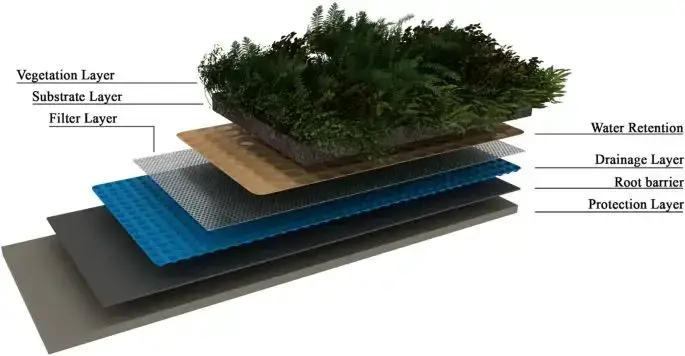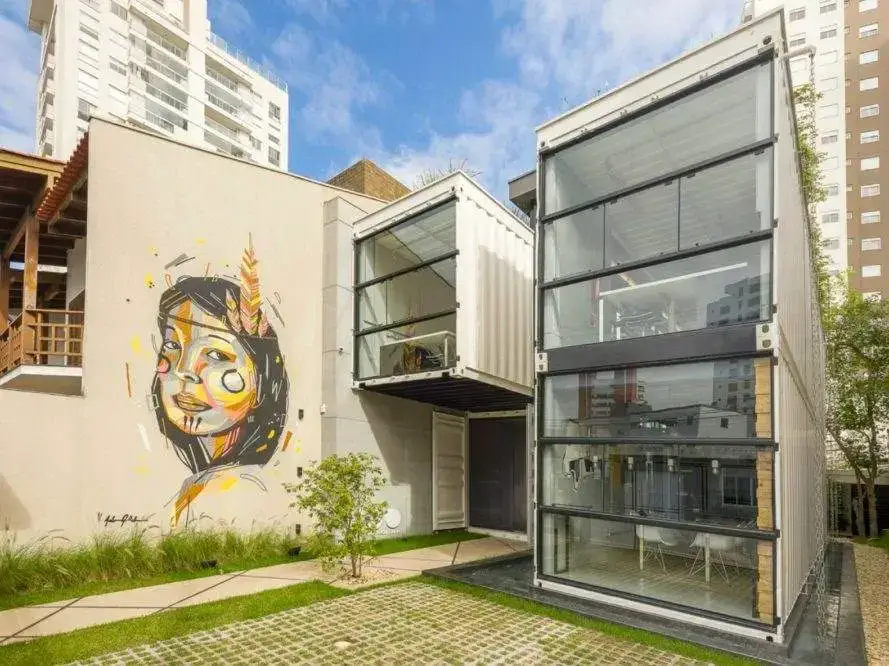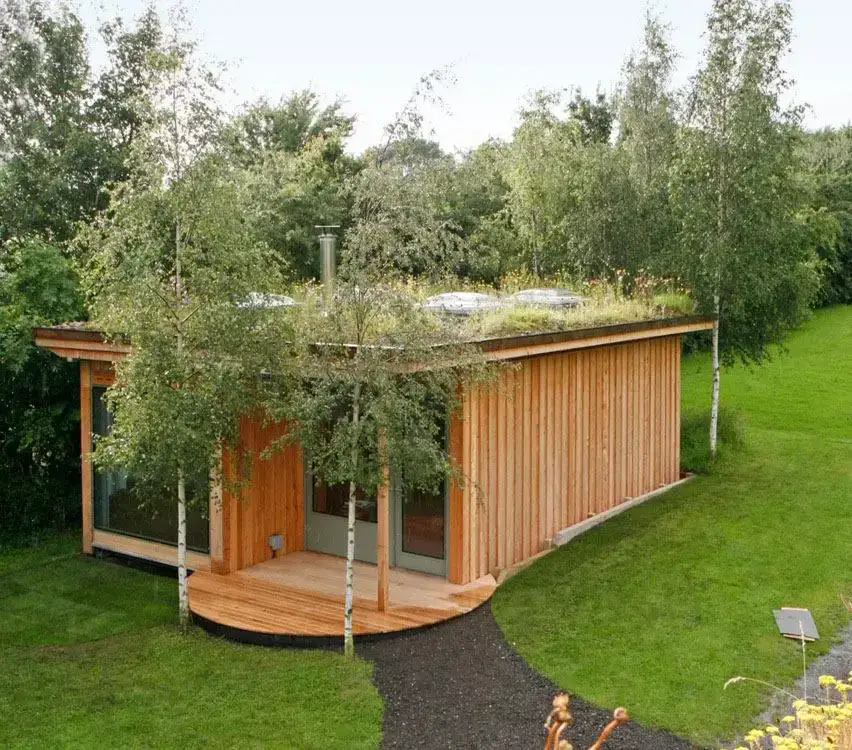Discover the innovative concept of green roofs and how they are revolutionizing sustainable architecture. In this article, we delve into the exciting realm of shipping container green roofs, exploring their unique potential benefits and contribution to a greener future.
What are Green Roofs?
Green roofs represent a powerful solution for incorporating nature back into urban landscapes. By covering rooftops with plants, they provide numerous environmental advantages, including improved air quality, reduced energy usage, stormwater management, and increased biodiversity.
Shipping Container Green Roofs: Uniting Sustainability and Industrial Design
One exciting adaptation of green roofs is their integration with shipping containers. By repurposing these sturdy metal structures, architects and designers can create remarkable green spaces on top of buildings or even as standalone structures.
The benefits of shipping container green roofs are manifold. They offer an innovative solution to limited urban space by utilizing otherwise unused rooftop areas.
Additionally, these living roofs help to insulate buildings, reduce the urban heat island effect, and provide natural habitats for wildlife.
Furthermore, shipping container green roofs contribute to sustainable waste management by reusing and upcycling materials that would otherwise go to waste.
By combining modern aesthetics with eco-friendly initiatives, they serve as a striking example of sustainable architecture at its finest.
Embrace the Future of Architecture with Shipping Container Green Roofs
As the demand for sustainable and eco-conscious designs continues to grow, shipping container green roofs offer a remarkable opportunity to transform the landscape of our cities.
Discover the endless possibilities and dive into a vibrant world where nature and industry coexist harmoniously.
Table of Contents
What is a Shipping Container Green Roof?

A shipping container green roof combines the concepts of sustainable architecture and vertical gardening to create an innovative and eco-friendly structure. It involves transforming a traditional shipping container into a thriving green space by adding a layer of vegetation on its roof.
The idea behind a shipping container green roof is to repurpose an existing container and turn it into a sustainable structure that promotes environmental benefits.
By adding a green roof on top, the container becomes an effective solution to urban greening, maximizing limited space, and improving biodiversity.
Read More on Are Container Homes Legal in Miami? Find Out the Facts!
Process of Adding a Container Green Roof
The process begins by selecting an appropriate shipping container, typically made of steel, which provides a strong and durable base for the green roof.
The container is then modified to accommodate the necessary components for the green roof system, ensuring proper drainage, insulation, and access.
Once the container is prepared, a layer of waterproofing material is applied to prevent water leakage. Next, a root barrier is added to protect the container’s structure from plant roots. A drainage layer is then installed to ensure excess water can safely drain away.
On top of the drainage layer, a growing medium is added, consisting of lightweight soil or a mixture of organic materials. This provides a suitable substrate for plants to grow, while also retaining and filtering rainwater.
The final step involves selecting and planting vegetation onto the green roof. Depending on the specific goals and climate conditions, a variety of plants can be chosen, ranging from low-growing sedums to more diverse species that support local ecosystems.
By transforming a shipping container into a green roof, numerous benefits are achieved. Firstly, it helps mitigate the urban heat island effect by reducing heat absorption and providing natural insulation. This contributes to energy efficiency and lowers cooling costs for buildings.
Additionally, a shipping container green roof improves air quality by capturing dust and pollutants, while also releasing oxygen through photosynthesis. It also serves as a habitat for insects, birds, and other wildlife, enhancing local biodiversity in urban areas.
In summary, a shipping container green roof is a sustainable and eco-friendly solution that repurposes existing infrastructure to create green spaces in urban environments.
It combines the functionality of a shipping container with the benefits of a green roof, making it an innovative solution towards promoting sustainable and healthier cities.
Benefits of a Shipping Container Green Roof
A shipping container green roof offers numerous benefits, making it an ideal choice for sustainable urban development. Here are some of the key advantages:
1. Environmental Advantages, Such as Improved Air Quality and Reduced Heat Island Effect
By incorporating vegetation into the rooftop, a shipping container green roof can help improve the overall air quality in urban environments.
Plants absorb carbon dioxide and release oxygen, reducing greenhouse gas emissions and air pollution. Additionally, the green roof mitigates the heat island effect by lowering surface temperatures and reducing energy consumption for cooling.
Read More on What Is Green Energy? Simplest Expert Explanation
2. Enhanced Energy Efficiency and Insulation Provided by the Green Roof
The layers of soil and plants on a shipping container green roof act as a natural insulator, providing enhanced thermal performance and reducing the need for artificial heating or cooling. This results in energy savings and decreased reliance on fossil fuels.
3. Utilization of Unused Rooftop Space for Vegetation and Urban Farming Initiatives
Shipping container green roofs offer a solution to the issue of limited urban green spaces. By utilizing otherwise unused rooftop areas, these green roofs promote urban farming initiatives and foster a closer connection between city dwellers and the food they consume.
This not only increases local food production but also enhances food security and supports sustainable living.
Read More on How Much Does A Used Shipping Container Cost? Expert Guide
4. Aesthetically Pleasing Design and Contribution to Urban Biodiversity
A shipping container green roof adds visual appeal to buildings, transforming rooftops into vibrant green spaces.
These green roofs not only enhance the building’s aesthetics but also contribute to urban biodiversity by providing habitats for birds, bees, insects, and other wildlife. They create a harmonious balance between human needs and the natural environment.
In conclusion, a shipping container green roof offers numerous benefits, including environmental advantages, energy efficiency, effective rooftop space utilization, and aesthetic contributions to urban biodiversity.
Incorporating these green roofs into urban design is a sustainable and effective solution that promotes a healthier and greener future for cities.
Read More on Can You Put A Shipping Container On Agricultural Land?
Components of a Shipping Container Green Roof
A shipping container green roof is composed of several key components that work together to create a sustainable and vibrant rooftop garden. These components include the roof, green roof system, shipping container, and building design.
Roof
The roof of a shipping container serves as the foundation for the green roof installation. It provides a sturdy and secure surface on which the green roof system can be built. The container’s top surface is often flat and level, making it an ideal base for a green roof.
Read More on How to Select a Perfect Roof for Your Shipping Container Home
Green Roof
The green roof system is made up of several layers that work together to support vegetation and provide necessary drainage and protection. The layers include:
- Vegetation: This layer consists of plants, grasses, or other types of vegetation that are specifically chosen for their ability to thrive in a rooftop environment.
- Growing Medium: The growing medium, also known as substrate or soil, is a specially formulated blend that provides nutrients, water, and support for the vegetation to grow.
- Drainage: Proper drainage is essential to prevent water from pooling on the roof. Drainage layers help to direct excess water away from the plants and prevent damage to the roof structure.
- Membrane: A waterproof membrane is installed underneath the growing medium to protect the roof from water infiltration and ensure the longevity of the green roof system.
Read More on In Depth Look At Shipping Container Homes In South Australia
Shipping Container
The shipping container itself plays a crucial role in supporting a green roof. Its structure provides a stable platform for the installation of the green roof system.
The container’s walls and flooring are modified to accommodate the necessary drainage and ensure proper integration with the overall design of the green building.
Building
The shipping container is seamlessly integrated into the overall design of the green building. Architects and designers carefully consider the placement and orientation of the containers to optimize sun exposure, natural ventilation, and aesthetic appeal.
The container becomes an integral part of the building’s design, adding uniqueness and sustainability to the overall structure.
Read More on Shipping Container Homes In Oklahoma: Stylish and Sustainable
Construction and Design Considerations
When it comes to creating a shipping container green roof, there are several important construction and design considerations to keep in mind.
These considerations will ensure that your green roof structure is not only aesthetically pleasing, but also functional and durable.
Step-by-step Guide on How to Convert a Shipping Container Into a Green Roof Structure
Converting a shipping container into a green roof structure may seem daunting, but with the right steps, it can be a manageable project. Here is a step-by-step guide to help you:
- Firstly, inspect the shipping container for any damages or rust that needs to be repaired.
- Secondly, clean the container thoroughly to remove any dirt or debris.
- Apply a waterproofing membrane to the container’s roof to prevent water damage.
- Install a drainage system, such as a layer of gravel or plastic drainage mats, to ensure proper water drainage.
- Add a layer of root barrier or geotextile fabric to prevent plant roots from penetrating the container’s roof.
- Place a growing medium, such as lightweight soil or a mixture of soil and compost, on top of the root barrier.
- Select appropriate plant species that can thrive in the specific weight, root depth, and climate conditions of your green roof.
- Plant the selected species evenly across the growing medium.
- Finally, regularly maintain and monitor the green roof to ensure its health and longevity.
Read More on How Much Is A Container Home in Florida? Your Ultimate Guide
Selection of Appropriate Plant Species, Taking Into Account Weight, Root Depth, and Climate Suitability
Choosing the right plant species is crucial for the success of your shipping container green roof. Consider the following factors:
- Weight: Opt for lightweight plant species to prevent excess pressure on the container’s structure.
- Root depth: Select plants with shallow root systems to minimize damage to the container’s roof.
- Climate suitability: Research and choose plant species that are suitable for the climate in which your green roof will reside.
Considerations for Drainage Systems and Waterproofing to Prevent Water Damage to the Container
Proper drainage systems and waterproofing are essential to protect the container from water damage. Ensure the following:
- Install a reliable drainage system, such as a layer of gravel or plastic drainage mats, to ensure excess water drains properly.
- Apply a waterproofing membrane to the container’s roof to create a barrier against water infiltration.
- Finally, regularly inspect and maintain the drainage system and waterproofing to prevent any leaks or blockages.
Case Studies: Shipping Container Green Roof Offices
Shipping container green roof offices are an innovative and sustainable solution for creating functional workspaces within urban environments.
Let’s explore some real-life examples of how shipping containers have been transformed into productive and eco-friendly office spaces.
1. Green-Roofed Container Home Office or Studio

Located in a bustling downtown area, this Green-Roofed container home office/studio is a home office working space that utilizes shipping containers as its core structure.
Indeed, by repurposing these containers, Urban Hub offers affordable and flexible office spaces to freelancers and startups.
The green roof on top of each container not only adds beauty to the workspace but also provides a natural insulation layer, regulating the temperature and reducing energy consumption. The incorporation of solar panels ensures a sustainable and eco-friendly source of electricity.
With its adaptable, cost-effective, and environmentally conscious design, Urban Hub sets an example for sustainable office spaces in the heart of the city.
Read More on Shipping Container Homes in Oregon: Sustainability And Style
2. Green Roofs Co-working Shipping Container Office in Brazil

Rodrigo Kirck Arquitetura is an innovative company that specializes in sustainable technologies. They’ve constructed an office from repurposed shipping containers, which perfectly aligns with their core values.
Basically, the green roof on this container office serves multiple purposes. Its insulating properties keep the interior cool during hot summer months, while also reducing noise pollution from the surrounding industrial area.
Subsequently, the addition of rainwater harvesting systems provides a self-sufficient water supply, minimizing the ecological impact.
Moreover, the exterior of the containers is covered in wood siding, blending the office perfectly with the natural surroundings and creating a pleasant work environment.
Read More on Container Pools In Brisbane: Expert Review
3. Garden Room Flue Container Home with Green Roof: A Modern House With a Small Carbon Footprint

Without a doubt, Garden Room Flue showcases how shipping container green roof homes can be a viable and efficient solution for homeowners.
The well-designed green roof not only enhances the building’s aesthetics but also contributes to improving the local air quality by filtering pollutants. To be sure, the efficient insulation of the house reduces the reliance on artificial heating or cooling systems, resulting in significant energy savings.
By incorporating sustainable features, such as rainwater harvesting and renewable energy sources, Garden Room Flue proves that modern container homes can be both stylish and environmentally conscious.
These case studies illustrate the immense potential of shipping container green roof offices. Not only do they offer a cost-effective and adaptable solution for office spaces, but they also contribute to sustainable development and promote a healthier work environment.
As businesses continue to seek innovative and eco-friendly solutions, shipping container green roofs are certain to play a prominent role in the future of office design.
Maintenance and Upkeep of a Shipping Container Green Roof
To point out, proper maintenance and upkeep are essential for ensuring the longevity and functionality of a shipping container green roof. Here are some recommended practices and tips to keep in mind:
1. Green Roof Vegetation Maintenance
- Regular Irrigation: The green roof vegetation requires sufficient water to thrive. With this in mind, establish a regular irrigation schedule to ensure proper moisture levels.
- Weeding: Periodically inspect the green roof for any weeds or undesirable plants. Without delay, remove them promptly to prevent competition for resources.
- Fertilization: Provide necessary nutrients to the vegetation through organic fertilizers or compost. Follow recommended guidelines for the type and frequency of fertilization.
- Pruning and Trimming: Trim any overgrown branches or foliage to maintain an organized and aesthetically pleasing appearance.
- Monitoring for Pests and Diseases: Regularly scan the green roof for signs of pests or diseases. Take appropriate measures, such as using organic pesticides or seeking professional assistance, to prevent infestations and damage.
2. Container Structure Inspection
- Regular Visual Inspection: Conduct routine inspections of the shipping container structure. Look for signs of rust, corrosion, or any structural damage that might compromise the integrity.
- Addressing Potential Issues: If any issues are identified during the inspections, take prompt action to rectify them. This may involve rust treatment, patching, or reinforcing weak areas.
- Roof Waterproofing: Ensure that the container roof remains watertight to prevent leaks and water damage. Inspect the roof sealant and recoat it as necessary.
3. Rainwater Harvesting Systems
- Irrigation Efficiency: Install rainwater harvesting systems to collect and store rainwater. Utilize this water for irrigation purposes, reducing the dependency on external water sources.
- Maintenance Use: Additionally, the harvested rainwater can be used for general maintenance, such as cleaning the green roof or performing structural washdowns.
- System Inspection: Regularly inspect the rainwater harvesting system for any blockages, leaks, or maintenance requirements. Clean or repair the system as needed.
By following these maintenance practices and tips, you can ensure that your shipping container green roof remains vibrant, structurally sound, and sustainable for years to come.
Economic and Social Implications of Shipping Container Green Roofs
Shipping container green roofs offer numerous economic benefits that contribute to cost savings and potential rental income.
One of the main advantages is their energy efficiency, which results in reduced heating and cooling costs for the buildings beneath.
Under those circumstances, the insulation properties of green roofs help to regulate indoor temperatures, decreasing the need for artificial heating and air conditioning systems.
Additionally, shipping container green roofs can provide rental income by transforming unused rooftop spaces into desirable office spaces.
The unique design of these green roofs creates a modern and sustainable work environment, attracting businesses and professionals seeking eco-friendly office spaces.
The rental income generated from these spaces can contribute to the overall economic viability of the building or development.
Furthermore, the social impact of shipping container green roofs is significant. The aesthetic enhancement they provide to the surrounding community improves the overall appearance of the area.
The lush plants and greenery create a visually pleasing environment, making it more enjoyable for residents and visitors alike.
In addition to the improved aesthetics, shipping container green roofs also increase access to green spaces in urban areas.
As cities become more densely populated, the availability of parks and green areas diminishes. By incorporating green roofs, communities can create valuable green spaces that promote relaxation, well-being, and connection with nature.
Lastly, shipping container green roofs contribute to urban sustainability goals and advocate for eco-friendly building practices.
By repurposing shipping containers and incorporating sustainable elements into the design, these roofs showcase the potential for sustainable urban development.
They serve as a visual reminder of the importance of environmental responsibility and inspire others to adopt eco-friendly building practices.
How Much Does A Green Roof Cost?
To be sure, the cost of a green roof varies, depending on its processes and components. If you prefer plants that require more intensive care than others, then growing them on your home’s roof will likely be more expensive than choosing a less demanding plant life.
You can save energy, reduce your carbon footprint and protect the environment by having insulation and air conditioning installed.
The price of a 1,500-square-foot green roof is around $22,000. The square footage affects other factors, like the materials you need and the plants best suited for your area.
Read More on Container Home Builders in Georgia: Whose The Best?
Important Requirements For A Shipping Container Green Roof
1. Suitable Load Bearing Structure
To illustrate, if you’ve ever been in an area with heavy snow or ice buildup, you know how much damage it can cause to roofs.
Shipping containers are very susceptible to this problem because they’re designed to be portable and lightweight.
And so this means they don’t have extra material surrounding them as regular houses do. Extreme weather could easily damage it beyond repair if there isn’t enough support beneath your container’s roof.
2. Waterproof Membrane
The waterproof membrane is the most important element of any green roof system. It must be a suitable material for the environment, able to withstand the weather and UV exposure while also being strong enough to bear weight.
Clear PVC membranes are common but can discolor over time and may become brittle under extreme heat or cold. Other considerations include how long it takes for moisture penetrates through your chosen membrane.
The longer this takes, the greater chance your roots will suffer from damping off disease or rot, and whether or not it allows air flow from below so as not to suffocate plants above ground level.
3. Air and Water Drainage Layer
This layer is essential. It allows air and water to flow through the roof, preventing water from pooling and roots from growing into the roof.
It also prevents soil compaction, which can occur when roots develop and create pressure on the soil’s surface.
4. Soil for Planting
Soil for planting should be good quality soil. The soil should be free of weeds, pests, and chemicals. In addition, it must be free of rocks, stones, and woody materials, making it difficult for plant roots to grow into the container’s substrate.
Conclusion
Finally, shipping container green roofs offer numerous benefits and potential for creating sustainable green spaces in urban areas.
Without a doubt, by utilizing unused shipping containers and transforming them into green roofs, we can contribute to a healthier and more environmentally friendly future.
Throughout this content, we have discussed the various benefits of shipping container green roofs, including improved energy efficiency, reduced stormwater runoff, enhanced biodiversity, and increased insulation. These green roofs also provide opportunities for recreational spaces and urban farming.
We have explored the components and construction considerations of shipping container green roofs, as well as highlighted several case studies showcasing their successful implementation in office spaces.
Furthermore, we have discussed the importance of regular maintenance in order to ensure the longevity and effectiveness of these green roofs.
Shipping container green roofs not only have economic benefits, such as potential cost savings on energy bills and increased property value, but also contribute to the social well-being of urban communities.
These green roofs can improve air quality, provide a peaceful retreat in busy cities, and foster a sense of community and connection with nature.
As individuals and organizations, we have the power to make a difference. We encourage you to consider implementing shipping container green roofs in your urban areas, whether it be on your own property or within your organization.
To point out, by investing in these sustainable solutions, we can create greener, healthier, and more sustainable cities for ourselves and future generations.
Read More on Shipping Container Basement: How To Burry A Container
Resources and Further Reading
Looking to learn more about shipping container green roofs? Here are some valuable resources and recommended reading:
Additional Information and Case Studies
- Green Roof Organization – A non-profit organization focused on promoting the benefits of green roofs. Visit their website at www.greenrooforganisation.org/.
- The Green Roof Manual: A Professional Guide to Design, Installation, and Maintenance – A comprehensive book by Edmund C. Snodgrass that covers all aspects of green roof design. Check it out here on Amazon.
- King County Green Roof Case Study Report – Explore real-life examples of shipping container green roof projects and their success stories. Click here to read more.
Organizations Specializing in Sustainable Architecture
- US Green Building Council (USGBC) – A leader in promoting sustainable building practices. Visit their website at www.usgbc.org.
- International Living Future Institute (ILFI) – An organization dedicated to creating a healthy and sustainable future through innovative design. Learn more at living-future.org.
Recommended Books and Articles
- The Sustainable Sites Handbook: A Complete Guide to the Principles, Strategies, and Best Practices for Sustainable Landscapes – A book by Meg Calkins that delves into sustainable landscape design. Find it here.
- Container Atlas: A Practical Guide to Container Architecture – Explore the world of container architecture with this informative book by Han Slawik. Order your copy here.
- Essential Green Roof Construction: The Complete Step-by-Step Guide (Sustainable Building Essentials Series) – A scholarly article by Leslie Doyle that examines the benefits of green roofs. Access it here.
To conclude, by consulting these resources and delving deeper into the subject, you’ll gain a wealth of knowledge about shipping container green roofs and sustainable architecture.

